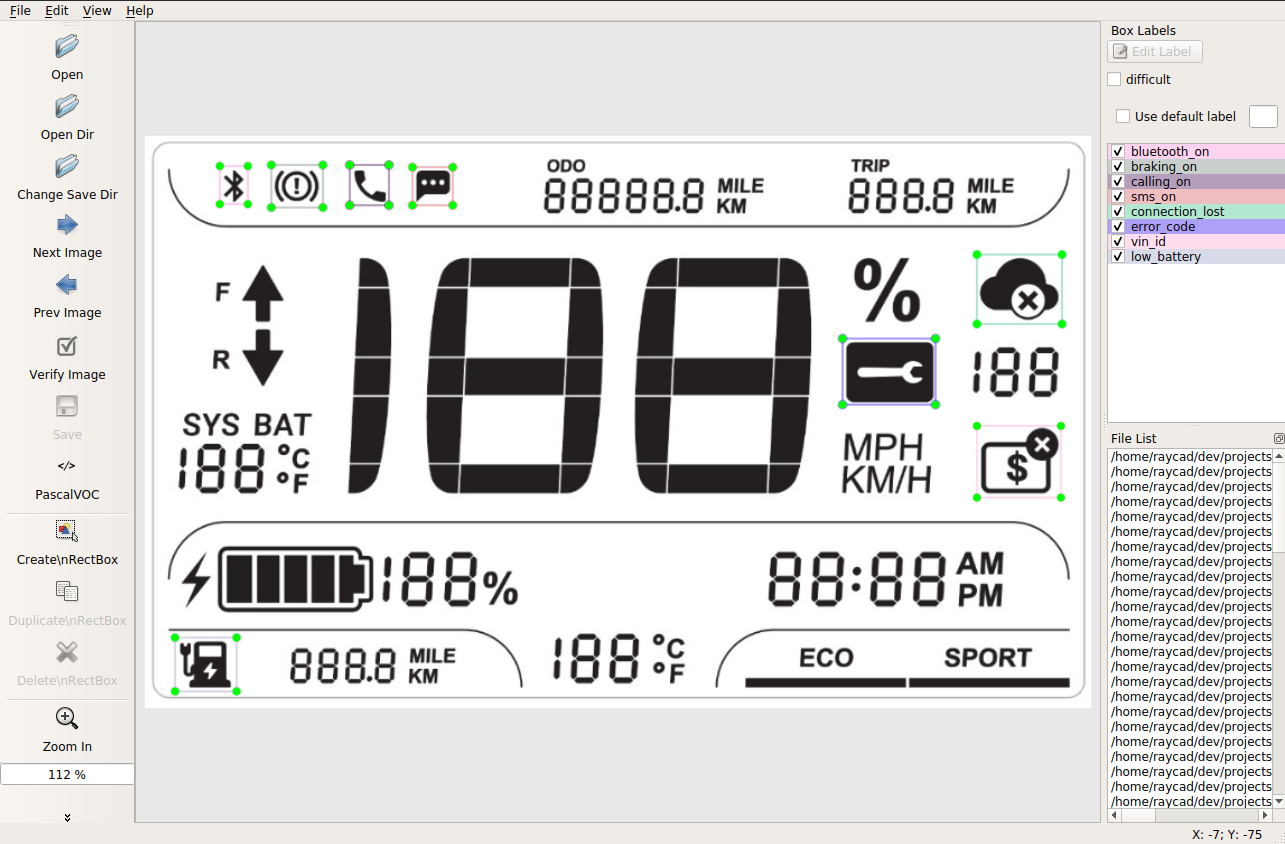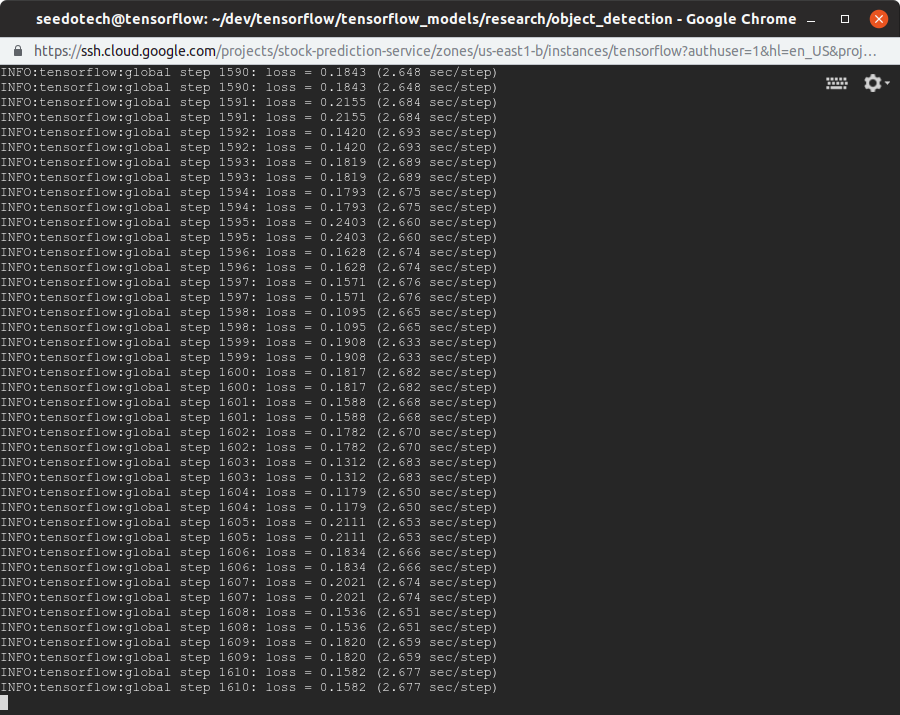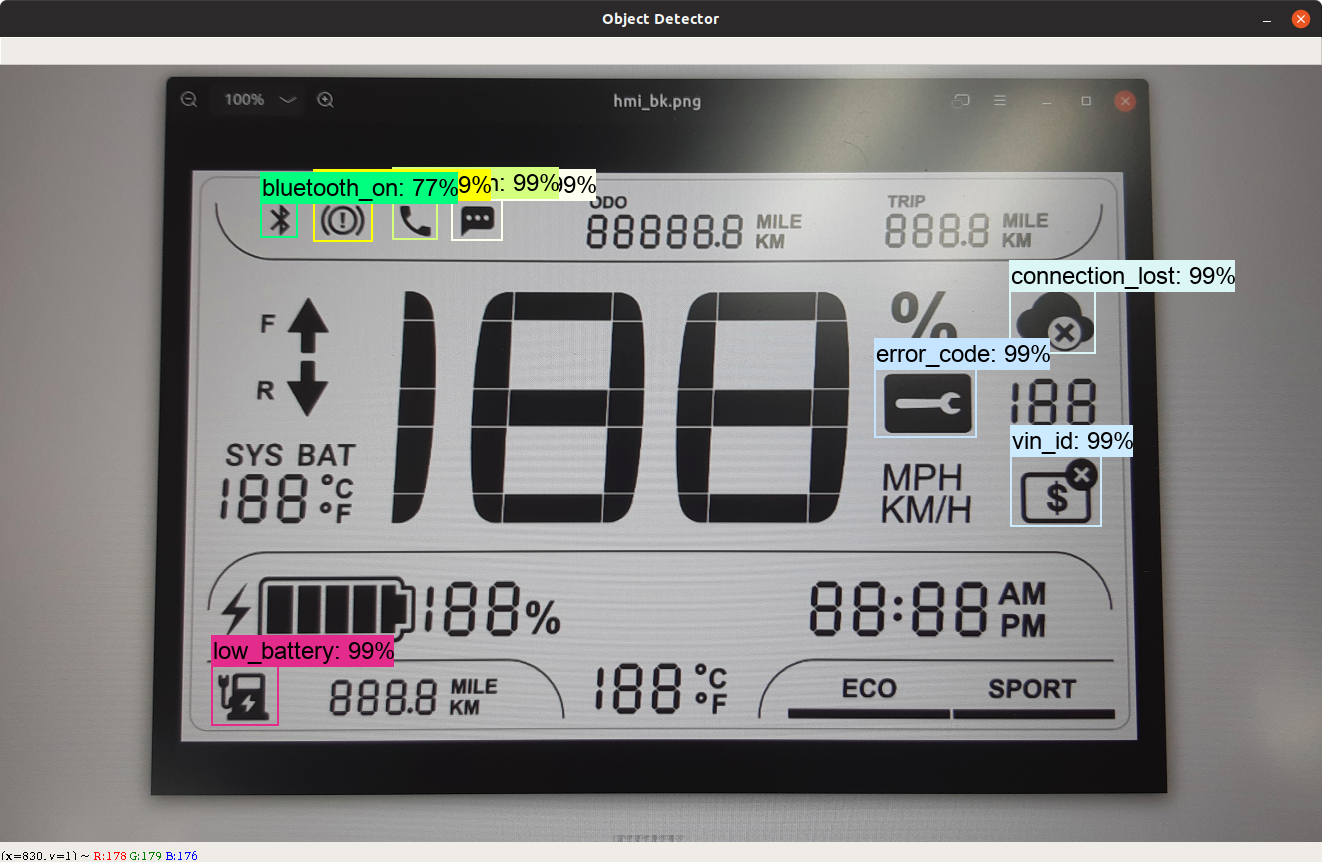-
The goal of this tutorial is to guide you how to apply Faster-RCNN to build and train step by step a model for the specific problem.
-
Regarding the concept of Faster-RCNN please take a look at the paper links:
-
The main source code is located in the folder: object-detection/research/object_detection
In QC Process we need to manually inspect the products to verify if the given icons on the products shown or not after performing an action. This tutorial will guide you how to apply Faster RCNN to automate testing HMI by recognizing the given icons shown or not in each test case.
# Download the latest Anaconda
$ wget https://repo.anaconda.com/archive/Anaconda3-2019.03-Linux-x86_64.sh
$ chmod a+x Anaconda3-2019.03-Linux-x86_64.sh
# Install the Anaconda
$ ./Anaconda3-2019.03-Linux-x86_64.sh
# Activating the Installation
$ source ~/.bashrc
# Install essential development packages
$ sudo apt install build-essential
$ git clone https://github.com/tensorflow/models.git tensorflow_models
$ git clone https://github.com/raycad/object-detection.git
Copy all source code from "object_detection_tutorial" to the "object-detection/research/object_detection" directory
$ cp -rf object_detection_tutorial/* object-detection/research/object_detection
$ conda create -n tensorflow_cpu pip python=3.6
# Activate the newly created virtual environment
$ conda activate tensorflow_cpu
# Deactivate created virtual environment
$ conda deactivate
# [NOTE]: Install one by one package
(tensorflow_cpu) seedotech@tensorflow:~/dev/tensorflow/object-detection/research/object_detection$ conda install -c anaconda protobuf
(tensorflow_cpu) seedotech@tensorflow:~/dev/tensorflow/object-detection/research/object_detection$ pip install pillow
(tensorflow_cpu) seedotech@tensorflow:~/dev/tensorflow/object-detection/research/object_detection$ pip install lxml
(tensorflow_cpu) seedotech@tensorflow:~/dev/tensorflow/object-detection/research/object_detection$ pip install Cython
(tensorflow_cpu) seedotech@tensorflow:~/dev/tensorflow/object-detection/research/object_detection$ pip install jupyter
(tensorflow_cpu) seedotech@tensorflow:~/dev/tensorflow/object-detection/research/object_detection$ pip install matplotlib
(tensorflow_cpu) seedotech@tensorflow:~/dev/tensorflow/object-detection/research/object_detection$ pip install pandas
(tensorflow_cpu) seedotech@tensorflow:~/dev/tensorflow/object-detection/research/object_detection$ pip install opencv-python
(tensorflow_cpu) seedotech@tensorflow:~/dev/tensorflow/object-detection/research/object_detection$ pip install pycocotools
# Upgrade the tensorflow. It works with tensorflow 1.13.0
(tensorflow_cpu) seedotech@tensorflow:~/dev/tensorflow/object-detection/research/object_detection$ pip install --upgrade tensorflow
$ pip list | grep tensorflow
tensorflow 1.13.1
tensorflow-estimator 1.13.0
NOTE: Every time the "tensorflow_cpu" virtual environment is exited, the PYTHONPATH variable is reset and needs to be set up again
(tensorflow_cpu) seedotech@tensorflow:~/dev/tensorflow/object-detection/research$ export PYTHONPATH=~/dev/tensorflow/object-detection:~/dev/tensorflow/object-detection/research:~/dev/tensorflow/object-detection/research/slim
(tensorflow_cpu) seedotech@tensorflow:~/dev/tensorflow/object-detection/research$ protoc ./object_detection/protos/*.proto --python_out=.
(tensorflow_cpu) seedotech@tensorflow:~/dev/tensorflow/object-detection/research$ python setup.py build
(tensorflow_cpu) seedotech@tensorflow:~/dev/tensorflow/object-detection/research$ python setup.py install
# Test TensorFlow setup to verify it works
(tensorflow_cpu) seedotech@tensorflow:~/dev/tensorflow/object-detection/research/object_detection$ jupyter notebook object_detection_tutorial.ipynb
Use LabelImg (https://github.com/tzutalin/labelImg) to label and make annotation images
# You can check if the size of each bounding box is correct by running size_checker.py
(tensorflow_cpu) seedotech@tensorflow:~/dev/tensorflow/object-detection/research/object_detection$ python size_checker.py --move
This creates a train_labels.csv and test_labels.csv file in the /object_detection/images folder
(tensorflow_cpu) seedotech@tensorflow:~/dev/tensorflow/object-detection/research/object_detection$ python xml_to_csv.py
Open the generate_tfrecord.py file in a text editor then replace the label map starting at line 31 with your own label map, where each object is assigned an ID number
# This same number assignment will be used when configuring the labelmap.pbtxt file
# Then, generate the TFRecord files by issuing these commands from the /object_detection folder
# These generate a train.record and a test.record file in "/object_detection". These will be used to train the new object detection classifier.
(tensorflow_cpu) seedotech@tensorflow:~/dev/tensorflow/object-detection/research/object_detection$ python generate_tfrecord.py --csv_input=images/train_labels.csv --image_dir=images/train --output_path=train.record
(tensorflow_cpu) seedotech@tensorflow:~/dev/tensorflow/object-detection/research/object_detection$ python generate_tfrecord.py --csv_input=images/test_labels.csv --image_dir=images/test --output_path=test.record
Download the model from http://download.tensorflow.org/models/object_detection/faster_rcnn_inception_v2_coco_2018_01_28.tar.gz
(tensorflow_cpu) seedotech@tensorflow:~/dev/tensorflow/object-detection/research/object_detection$ wget http://download.tensorflow.org/models/object_detection/faster_rcnn_inception_v2_coco_2018_01_28.tar.gz
# Extract the faster_rcnn_inception_v2_coco_2018_01_28 folder to the "object_detection" folder
(tensorflow_cpu) seedotech@tensorflow:~/dev/tensorflow/object-detection/research/object_detection$ tar -zxvf faster_rcnn_inception_v2_coco_2018_01_28.tar.gz
# Create Label Map and Configure Training
# Update information of the files in the "object-detection/research/object_detection/training" folder. Note to set the absolute path for "fine_tune_checkpoint", "train_input_reader" and "eval_input_reader"
Line 9. Change num_classes to the number of different objects you want the classifier to detect. For the above basketball, shirt, and shoe detector, it would be num_classes : 3 .
fine_tune_checkpoint: "/home/seedotech/dev/tensorflow/object-detection/research/object_detection/faster_rcnn_inception_v2_coco_2018_01_28/model.ckpt"
train_input_reader: {
tf_record_input_reader {
input_path: "/home/seedotech/dev/tensorflow/object-detection/research/object_detection/train.record"
}
label_map_path: "/home/seedotech/dev/tensorflow/object-detection/research/object_detection/training/labelmap.pbtxt"
}
eval_config: {
# Change num_examples to the number of images you have in the /images/test directory.
num_examples: 16
# Note: The below line limits the evaluation process to 10 evaluations.
# Remove the below line to evaluate indefinitely.
max_evals: 10
}
eval_input_reader: {
tf_record_input_reader {
input_path: "/home/seedotech/dev/tensorflow/object-detection/research/object_detection/test.record"
}
label_map_path: "/home/seedotech/dev/tensorflow/object-detection/research/object_detection/training/labelmap.pbtxt"
shuffle: false
num_readers: 1
}
(tensorflow_cpu) seedotech@tensorflow:~/dev/tensorflow/object-detection/research/object_detection$ python model_main.py --logtostderr --train_dir=training/ --pipeline_config_path=training/faster_rcnn_inception_v2_pets.config
# Run with old train.py"
# Move train.py from /object_detection/legacy into the /object_detection folder and then continue following the steps below
(tensorflow_cpu) seedotech@tensorflow:~/dev/tensorflow/object-detection/research/object_detection$ cp legacy/train.py .
(tensorflow_cpu) seedotech@tensorflow:~/dev/tensorflow/object-detection/research/object_detection$ python train.py --logtostderr --train_dir=training/ --pipeline_config_path=training/faster_rcnn_inception_v2_pets.config
Now that training is complete, the last step is to generate the frozen inference graph (.pb file). From the /object_detection folder, issue the following command, where “XXXX” in "model.ckpt-XXXX" should be replaced with the highest-numbered .ckpt file in the training folder:
(tensorflow_cpu) seedotech@tensorflow:~/dev/tensorflow/object-detection/research/object_detection$ python export_inference_graph.py --input_type image_tensor --pipeline_config_path training/faster_rcnn_inception_v2_pets.config --trained_checkpoint_prefix training/model.ckpt-XXXX --output_directory inference_graph
e.g.
(tensorflow_cpu) seedotech@tensorflow:~/dev/tensorflow/object-detection/research/object_detection$ python export_inference_graph.py --input_type image_tensor --pipeline_config_path training/faster_rcnn_inception_v2_pets.config --trained_checkpoint_prefix training/model.ckpt-10000 --output_directory inference_graph
This creates a frozen_inference_graph.pb file in the /object_detection/inference_graph folder. The .pb file contains the object detection classifier.
Edit the line 51 in the object_detection_image.py file to the number of classes the object detector can identify
$ python object_detection_image.py
16.1. File "/home/seedotech/anaconda3/envs/tensorflow_cpu/lib/python3.6/site-packages/object_detection-0.1-py3.6.egg/object_detection/utils/learning_s
chedules.py", line 160, in manual_stepping raise ValueError('First step cannot be zero.') ValueError: First step cannot be zero.
[FIX]
$ nano utils/learning_schedules.py
Then uncomment 2 lines in line 160:
#if boundaries and boundaries[0] == 0:
# raise ValueError('First step cannot be zero.')
INFO:tensorflow:global step 5778: loss = 0.0613 (2.646 sec/step)
INFO:tensorflow:global step 5778: loss = 0.0613 (2.646 sec/step)
INFO:tensorflow:global step 5779: loss = 0.0551 (2.673 sec/step)
INFO:tensorflow:global step 5779: loss = 0.0551 (2.673 sec/step)
INFO:tensorflow:global step 5780: loss = 0.0558 (2.737 sec/step)
INFO:tensorflow:global step 5780: loss = 0.0558 (2.737 sec/step)
INFO:tensorflow:global step 5781: loss = 0.0759 (2.663 sec/step)
INFO:tensorflow:global step 5781: loss = 0.0759 (2.663 sec/step)
INFO:tensorflow:global step 5782: loss = 0.0798 (2.706 sec/step)
INFO:tensorflow:global step 5782: loss = 0.0798 (2.706 sec/step)
INFO:tensorflow:global step 5783: loss = 0.0396 (2.661 sec/step)
INFO:tensorflow:global step 5783: loss = 0.0396 (2.661 sec/step)
Killed
It was caused by out-of-memory. Please check your RAM consumption.
https://github.com/tensorflow/models
https://cloud.google.com/solutions/creating-object-detection-application-tensorflow
https://tensorflow-object-detection-api-tutorial.readthedocs.io/en/latest/training.html


